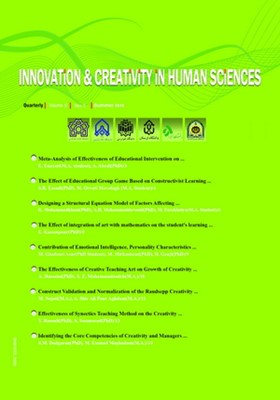-
-
List of Articles
-
Open Access Article
1 - Meta-analysis of effectiveness of Educational intervention on creativity of students
Elaheh Enayati Ahmad Abedi -
Open Access Article
2 - The Effect of Educational Group Game Based on Constructivist Learning on Training of Creative Thinking Skill of preschool children
Seyed Rasoul emadi Mahin Orvati movafagh -
Open Access Article
3 - Developing a Structural Equation Model of Factors Affecting tend to Critical Thinking of Teachers of Karaj Education Dept., District 4.
Kamran Mohammad Khani Amir Hosrin MohammadDavidi Maryam Farokh Nia -
Open Access Article
4 - The Effect of integration of art with mathematics on the student's learning and creativity
esmaeil kazempour -
Open Access Article
5 - Contribution of emotional intelligence, personality characteristics and demographic factors mediated by achievement motivation in explaining creativity of high school students
Maryam GhaforiAsar Malek MirHashemi Hamzeh Ganji -
Open Access Article
6 - the effectiveness of creative teaching Art on growth of creativity in third grade students of elementary school
Afzalosadat Hoseini Seyedeh Zohreh Mohammadzadeh -
Open Access Article
7 - Construct Validation and Normalisation of The Raudsepp Creativity Questionnaire among High School Students
Mohaddeseh Nejati asghar shir alli pour -
Open Access Article
8 - Effectiveness of Synectics Teaching Method on the creativity and academic achievement of students
Yosef Rasoli Abolghasem EsaMorad -
Open Access Article
9 - Identify the core competencies of creativity and managers of private newspapers
Mohammad Dadgran Mojtaba Etemadmoghaddam
-
The rights to this website are owned by the Raimag Press Management System.
Copyright © 2021-2025







